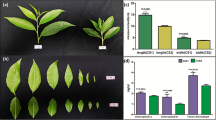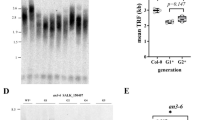Abstract
The circadian clock governs rhythms with 24 hours that allow organisms to anticipate daily changing environmental time cues. In Arabidopsis, the circadian clock is conceptually composed of three parts; input pathways for light and temperature signals, oscillators and output pathways for physiological processes including leaf movement, gene expression rhythms and flowering time. Oscillators consist of three interlocking loops, named morning, central and evening loops. Components of the central oscillator contain LHY, CIRCADIAN CLOCK ASSOCIATED1 (CCA1) and TIMING OF CAB EXPRESSION (TOC1). The oscillator can be reset by light signals through input pathways. Genetic studies have revealed the components involved in light input pathways. The elf3 (early flowering 3) mutant was isolated by insensitivity to photoperiod showing long hypocotyls, elongated petioles and pale leaves characteristic of plants defective in light perception. Therefore the ELF3 has been proposed to act on light input pathways. The aim of this study is to test whether LHY and ELF3 encode interacting components of a circadian light input pathway. To address this possibility, lhy-1 elf3-1 (LHY overexpressing-mutant X ELF3 loss of function-mutant) and lhy-11 elf3-1 (LHY loss of function-mutant X ELF3 loss of function-mutant) double mutants were constructed. Their visual phenotypes and CAB (Chlorophyll a/b binding protein) expression patterns demonstrate that LHY may function downstream of ELF3 and that this interaction is disrupted when LHY expression is placed under the control of the 35S promoter. In addition, ELF3 is required for vigorous rhythms of LHY gene expression and LHY protein levels.
Similar content being viewed by others
References
Alabadi D, Oyama T, Yanovsky MJ, Harmon FG, Mas P and Kay SA (2001) Reciprocal regulation between TOC1 and LHY/CCA1 within the Arabidopsis circadian clock. Science 293: 880–883.
Baker CL, Loros JJ and Dunlap JC (2011) The circadian clock of Neurospora crassa. FEMS Microbiol. Rev. 36: 95–110.
Chaves I, Pokorny R, Byrdin M, Hoang N, Ritz T, Brettel K, Essen LO, van der Horst G.T, Batschauer A and Ahmad M (2011) The cryptochromes: blue light photoreceptors in plants and animals. Annu. Rev. Plant Biol. 62: 335–364.
Covington MF, Panda S, Liu XL, Strayer CS, Wagner DR and Kay SA (2001) ELF3 modulates resetting of the circadian clock in Arabidopsis. Plant Cell 13: 1305–1315.
Covington MF, Maloof JN, Straume M, Kay SA and Harmer SL (2008) Global transcriptome analysis reveals circadian regulation of key pathways in plant growth and development. Genome Biol. 9, R130.
Crosthwaite SK, Loros JJ and Dunlap JC (1995) Light-induced resetting of a circadian clock is mediated by a rapid increase in frequency transcript. Cell 81: 1003–1012.
Dixon LE, Knox K, Kozma-Bognar L, Southern MM, Pokhilko A and Millar AJ (2011) Temporal repression of core circadian genes is mediated through EARLY FLOWERING 3 in Arabidopsis. Curr. Biol. 21: 120–125.
Dunlap JC (1999) Molecular bases for circadian clocks. Cell 96: 271–290.
Fowler S, Lee K, Onouchi H, Samach A, Richardson K, Morris B, Coupland G. and Putterill J (1999) GIGANTEA: a circadian clock-controlled gene that regulates photoperiodic flowering in Arabidopsis and encodes a protein with several possible membrane-spanning domains. EMBO J. 18: 4679–4688.
Hardin PE (2011) Molecular genetic analysis of circadian timekeeping in Drosophila. Adv. Genet. 74: 141–173.
Harmer SL, Hogenesch JB, Straume M, Chang H-S, Han B, Zhu T, Wang X, Kreps JA and Kay SA (2000) Orchestrated Transcription of Key Pathways in Arabidopsis by the Circadian Clock. Science 290: 2110–2113.
Heintzen C, Loros JJ and Dunlap JC (2001) The PAS protein VIVID defines a clock-associated feed-back loop that represses light input, modulates gating, and regulates clock resetting. Cell 104: 453–464.
Hicks KA, Albertson TM and Wagner DR (2001) EARLY FLOWERING 3 encodes a novel protein that regulates circadian clock function and flowering in Arabidopsis. Plant Cell 13: 1281–1292.
Hicks KA, Millar AJ, Carré IA, Somers DE, Straume M, Meeks-Wagner DR and Kay SA (1996) Conditional circadian dysfunction of the Arabidopsis early-flowering 3 mutant. Science 274: 790–792.
Huq E, Tepperman JM, and Quail PH (2000) GIGANTEA is a nuclear protein involved in phytochrome signaling in Arabidopsis Proc. Natl. Acad. Sci. USA 97: 9789–9794.
Kim JY, Song H-R, Taylor BL and Carre IA (2003) Light-regulated translation mediates gated induction of the Arabidopsis clock protein LHY. The Embo J. 22: 935–944.
Kim WY, Hicks KA and Somers DE (2005) Independent roles for EARLY FLOWERING 3 and ZEITLUPE in the control of circadian timing, hypocotyl length, and flowering time. Plant Physiol. 139: 1557–1569.
Lee C, Parikh V, Itsukaichi T, Bae K and Edery I (1996) Resetting the Drosophila clock by photic regulation of PER and a PER-TIM complex. Science 271: 1740–1744.
Liu XL, Covington MF, Fankhauser C, Chory J and Wagner DR (2001) ELF3 encodes a circadian clock-regulated nuclear protein that functions in an Arabidopsis PHYB signal transduction pathway. Plant Cell 13: 1293–1304.
Locke JC, Kozma-Bognar L, Gould PD, Feher B, Kevei E, Nagy F, Turner MS, Hall A and Millar AJ (2006) Experimental validation of a predicted feedback loop in the multi-oscillator clock of Arabidopsis thaliana. Mol. Syst. Biol. 2, 59.
Lowrey PL and Takahashi JS (2011) Genetics of circadian rhythms in Mammalian model organisms. Adv. Genet. 74: 175–230.
Lu SX, Webb CJ, Knowles SM, Kim SH, Wang ZY and Tobin EM (2012) CCA1 and ELF3 Interact in the Control of Hypocotyl Length and Flowering Time in Arabidopsis. Plant Physiol. 158: 1079–1088.
McWatters HG and Devlin PF (2011) Timing in plants-a rhythmic arrangement. FEBS Lett. 585: 1474–1484.
McWatters HG, Bastow RM, Hall A and Millar AJ (2000) The ELF3 zeitnehmer regulates light signalling to the circadian clock. Nature 408: 716–719.
Millar AJ and Kay SA (1996). Integration of circadian and phototransduction pathways in the network controlling CAB gene expression in Arabidopsis. Proc. Natl. Acad. Sci. USA 93: 15491–15496.
Millar AJ, Carré IA, Strayer CA, Chua N-H and Kay SA (1995) Circadian clock mutants in Arabidopsis identified by luciferase imaging. Science 267: 1161–1163.
Millar AJ, Short SR, Hiratsuka K, Chua N-H and Kay SA (1992) Firefly luciferase as a reporter of regulated gene expression in higher plants. Plant Mol. Biol. Rep. 10: 324–337.
Mizoguchi T, Wheatley K, Hanzawa Y, Wright L, Mizoguchi M, Song H-R, Carré IA and Coupland G (2002) LHY and CCA1 are partially redundant genes required to maintain circadian rhythms in Arabidopsis. Dev. Cell 5: 629–641.
Myers MP, Wager-Smith K, Rothenfluh-Hilficker A and Young MW (1996) Light-induced degradation of TIMELESS and entrainment of the Drosophila circadian clock. Science 271: 1736–1740.
Nakamichi N (2011) Molecular mechanisms underlying the Arabidopsis circadian clock. Plant Cell Physiol. 52: 1709–1718.
Neff MM, Fankhauser C and Chory J (2000) Light: an indicator of time and place. Genes Dev. 14: 257–271.
Roden LC, Song H-R, Jackson S, Morris K and Carré IA (2002) Floral responses to photoperiod are correlated with the timing of rhythmmic gene expression relative to dawn and dusk, in Arabidopsis. Proc. Natl. Acad. Sci. USA 99: 13313–13318.
Schaffer R, Ramsay N, Samach A, Corden S, Putterill J, Carré IA and Coupland G. (1998) The late elongated hypocotyl mutation of Arabidopsis disrupts circadian rhythms and the photoperiodic control of flowering. Cell 93: 1219–1229.
Shigeyoshi Y, Taguchi K, Yamamoto S, Takekida S, Yan L, Tei H, Moriya T, Shibata S, Lolos JJ, Dunlap JC and Okamura H (1997) Light-induced resetting of a mammalian circadian clock is associated with rapid induction of the mPer1 transcript. Cell 91: 1043–1053.
Somers DE, Devlin PF and Kay SA (1998) Phytochromes and cryptochromes in the entrainment of the Arabidopsis circadian clock. Science 282: 1488–1490.
Song H-R and Carré IA (2005) DET1 regulates the proteasomal degradation of LHY, a component of the Arabidopsis circadian clock. Plant Mol. Biol. 57: 761–771
Wenden B, Kozma-Bognar L, Edwards KD, Hall AJ, Locke JC and Millar AJ (2011) Light inputs shape the Arabidopsis circadian system. Plant J. 66: 480–491.
Zagotta MT, Hicks KA, Jacobs CI, Young JC, Hangarter RP and Meeks-Wagner DR (1996) The Arabidopsis ELF3 gene regulates vegetative morphogenesis and the photoperiodic induction of flowering. Plant J. 10: 691–702.
Zeng H, Qian Z, Myers MP and Rosbash M (1996) A light-entrainment mechanism for the Drosophila circadian clock. Nature 380: 129–135.
Author information
Authors and Affiliations
Corresponding author
Rights and permissions
About this article
Cite this article
Song, HR. Interaction between the Late Elongated hypocotyl (LHY) and Early flowering 3 (ELF3) genes in the Arabidopsis circadian clock. Genes Genom 34, 329–337 (2012). https://doi.org/10.1007/s13258-012-0011-2
Received:
Accepted:
Published:
Issue Date:
DOI: https://doi.org/10.1007/s13258-012-0011-2




